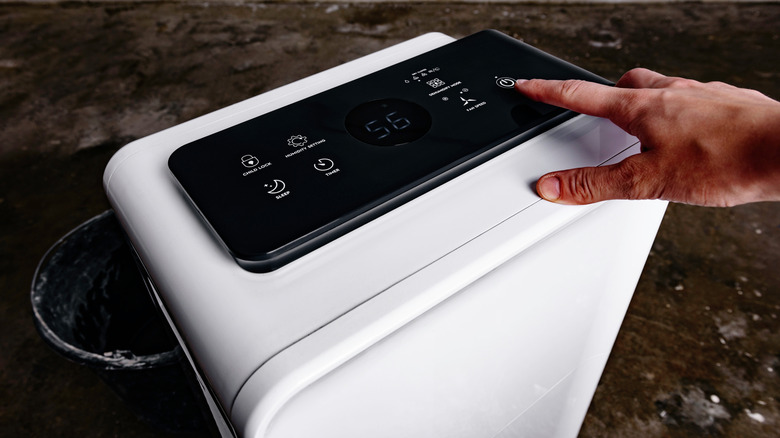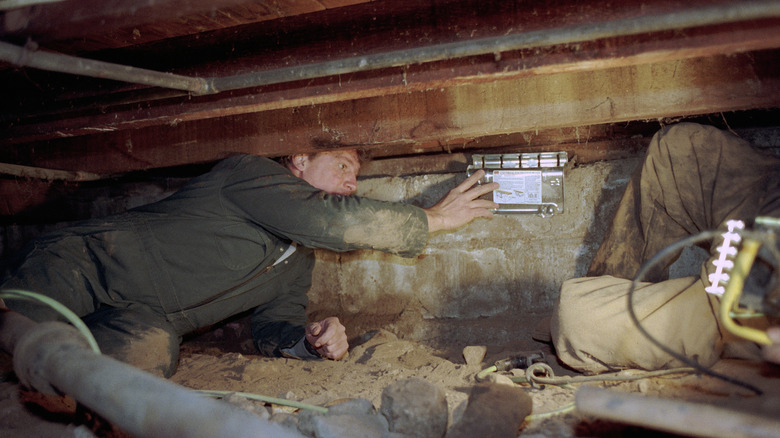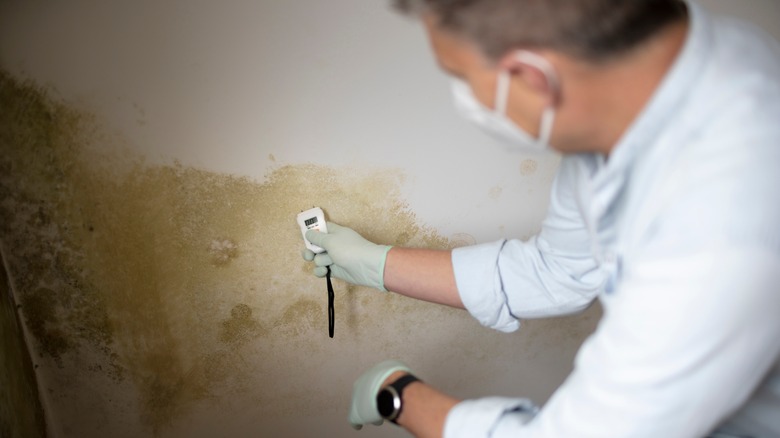Should You Dehumidify Before Cleaning Mold From Your Crawl Space?
We may receive a commission on purchases made from links.
You probably don't spend much time in the crawl space below your house. However, keeping a close eye on it is important to ensure the shallow, unfinished area doesn't suddenly become covered with mold. Designed to contain your home's plumbing, electrical, and HVAC systems in an easily accessible spot that costs less than a basement, crawl spaces are frequently damp due to poor ventilation and drainage. Because of these conditions, it's easy for fuzzy or slimy mold to quickly take hold, growing on the soil, walls, and wood beams. If this happens, the mold should be removed as soon as possible — and you should dehumidify the area before doing so, according to mold and air quality expert and HomeCleanse founder Michael Rubino.
In an exclusive interview with House Digest, Rubino said dehumidifying is a crucial aspect of remediation because it's important to resolve issues that led to mold in the first place. "If the humidity remains high, mold can begin growing once again in the crawlspace," he said. "This means that the monetary investment in remediation will need to be made again." Rubino says the main reason to dehumidify first is to immediately start limiting exposure to the most common types of mold for anyone living in your home. "When humidity is too high, it can cause microbial growth, poor indoor air quality, and structural issues in the building," he warned.
Monitor and maintain the moisture levels in your crawl space
In his exclusive interview with House Digest, Michael Rubino explained that your home's crawl space profoundly affects the interior humidity, and it should be carefully monitored. "The ideal level for indoor humidity should be between 35 and 50%," he said. "A great idea is to place a hygrometer in the space ... Get one that will alert you if humidity levels get too high so that you can take action to resolve the issue." He also pointed out that some dehumidifiers are specifically designed to maintain ideal crawl space humidity levels, like this ARGENDON Dehumidifier for Crawlspace and Basement.
One of the main reasons you should dehumidify before cleaning mold from your crawl space is that it doesn't take long to grow back. "Some species of mold can grow in as little as 24 to 48 hours if provided with a source of moisture," Rubino told us. "That is why time is of the essence for dealing with water damage or any sort of moisture-related event." This means keeping a close eye on your crawl space for any evidence of mold, especially after any major rain or flooding event.
Resist the urge to overdry your crawl space. "You don't want it to be too dry," warned Rubino. "This can lead to adverse health reactions and structural issues, such as wood separation." Cracks, splits, and warping can occur if you overdo the dehumidification process, and the fix will be just as expensive whether the wood is moldy and rotten from too much moisture or loses its integrity from overdrying.
Leave mold removal to the professionals
The financial and structural risks of improper mold and moisture remediation are high. "Hiring a professional is best because the process is intensive, and it is difficult to do properly in a confined area like a crawl space," Michael Rubino told House Digest during his exclusive interview. He advised that successful remediation should check three boxes: It should identify and address the problems that led to the moisture and mold, it should eradicate all toxins and bacteria present, and it should involve using the correct products and procedures for all surface types in your crawl space.
Getting rid of water that's flooded your crawl space is a significant undertaking. "If every point of the remediation process is not addressed, the remediation will likely fail," Rubino cautioned. "The conditions for growth [will] remain, allowing the problem to return." He added that improper procedures won't address the roots of mold, especially on wood. "Because of its porosity, unsealed wood requires abrasive methodologies to remediate properly," Rubino explained.
He added that failed remediation not only wastes time and money, but it can also be detrimental to your wellness because of the impact on indoor air quality. It's important to keep your family's health in mind throughout the dehumidifying and mold removal processes. "Projects should use engineering controls, personal protective equipment (PPE), and proper remediation protocols to avoid inhaling aerosolized particles and prevent cross-contamination," Rubino advised.


